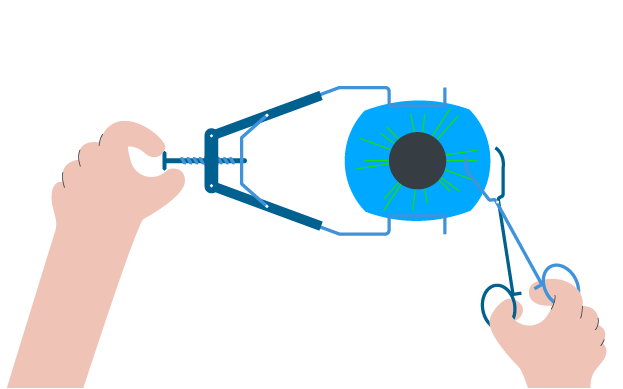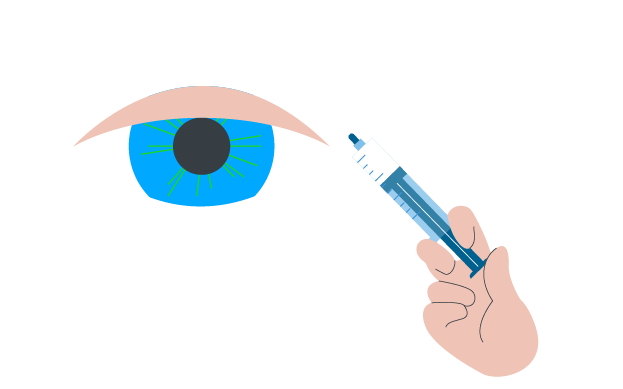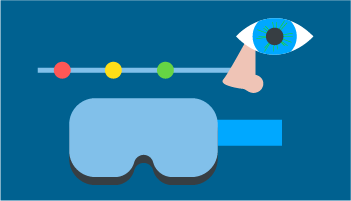Up to 4% of US citizens suffer from misaligned eyes. Some of them have developed a lazy eye over their lifetime. Other people are born pre-maturely – and got it at birth. [1]
So did I.

Since birth my lazy eye was a constant companion. And like so many other people either born with a lazy eye – or people that developed it over time – I tried everything to fix it. Here are the methods that work for an adult. Rated by risk, effectiveness, pricing, novelty and effort required.
Option 1
Lazy Eye Surgery
Surgery is the go-to method for fixing a lazy eye. 1,2 million surgeries are done per year in the United States, which makes it a routine procedure.[2]
It’s performed by a doctor – and the results – next to a lengthy prior consultation/waiting process are immediate.

1.1 How Does Lazy Eye Surgery Work?
- Identifying the exact deviation angle of your eyes (done by an eye doctor)
- Double checking the results and clarifying any questions by the surgeon
- Doing the actual surgery
The lazy eye surgery is done under general anaesthesia – and is a standard procedure.
Serious complications are rare – and very similar to other types of surgery. Here are all complications sorted by prevalence: [3]
1
100% chance of conjunctival injection
(inflammation of the eye tissue due to the surgical procedure, completely normal)
2
90% chance of visible post-operative scar
(often minor -but can be severe)
3
3.2-4.3% Corneal Dellen
(interruption of the tear film, resulting in dehydration of the eye)
4
2.1% Pyogenic granuloma
(small, raised red bumps)
5
0.4-18% Scleral perforation
6
1 in 1,500 Slipped muscle
7
1 in 4,800 Lost muscle
8
1 in 14,000 Pulled-in-two syndrome
9
1 in 1,100-1,900 Periorbital / orbital cellulitis
10
1 in 39,600 Retinal detachment
The success rate of a surgery is estimated to be between 57-80%. The average prism dioptres after surgery is 6 +/- 4.9. [5][6]
Considering that recent studies indicate that 4 prism dioptres are required for optimal binocular fusion – which indicates long-term success – actual success rate may be as low as 20,4% (considering normal, gaussian distribution with above standard deviation).[7][8]

It’s an effective method, but most people will need a multitude of surgeries over their lifetime. Approx. 10% of the people who do the surgery, need to do a re-operation within a year.[9][10]
Studies on actual re-operation rate do not take into account patient satisfaction and dissatisfaction– as not all dissatisfied patients will make the decision to undergo the procedure again.
The reason for the high re-operation rate is that the procedure – from assessment to surgery – is complex. There are a multitude many potential pitfalls during this process, including:

It is estimated that human error (errors of your doctor and surgeon) are responsible for about 50% of all re-operations.[11]
So people looking to have the surgery should pick and choose both their eye doctors - and surgeons wisely.
1.2 My experience with surgery:
I’ve had a Minimal Invasive Strabismus Surgery (MISS) in 2019.[12]

Although the surgery was done incredibly well by the surgeon - which happened to be the inventor of MISS – I would honestly not do it again.
I got zero complications and the recovery time of the surgery (2 weeks) was small, but my eyes started slipping off about 3-4 weeks later.
“Your eye just slipped off, again.” – I still remember my brother telling me this during a family dinner. It’s a horrible feeling to hear that what you hoped would be an end of your struggle – was just a temporary relief.
6 months after the surgery the eyes were unfortunately as misaligned as before.
1.3 Overall verdict:
Risk

Effectiveness

Pricing

Novelty

Effort required

Option 2
Botulinum Toxin (Botox)
Botulinium Toxin is a neurotoxin that
normally gets used by plastic surgeons for re-juvenation purposes.[14]
In 1980 Botox got first used for improvements in strabismus.[15]
The treatment of botox primarily serves as an alternative to surgery for adults. It has a success rate of 76% (similar to surgery).

It is not the go-to treatment for children, due to the common compliation of ptosis (27% of all botox injections).[16]
Which is where the toxin leaks into the levator palpebral superioris muscle (the muscle responsible for elevating the eyelid) thus resulting in a droopy upper lid (ptosis).[17]
2.1 How Does Botox Work For Lazy Eye?
- Botulinum toxin gets injected into the eye muscle.
- The toxin works by blocking the release of acetylcholine, thereby blocking the nerve impulse.
- The given eye muscle can’t contract, resulting in (temporary) paralysis.
- The paralysis of the given muscle – and therefore the changes of eye angle due to the botox injection - resolves over time (usually 2-3 months).
- The botox injection needs to be repeated if the result was desirable.
2.2 My Experience With Botox
Due to high complication rate of ptosis (1 out of 3 patients), I did not try Botulinum Toxin.
2.3 Verdict
Do not recommend. Effectiveness and risks do not stand in proper balance to each other.
Risk

Effectiveness

Good, but not as good as surgery.
Pricing

Novelty

Effort required

Option 3
Vision Therapy
Vision therapy has gained
popularity in recent years.
Especially since neuroscientist Susan Barry (Stereosue)
gained full stereo-vision as an adult. And this after a life-time of strabismus.[18]

3.1 How Vision Therapy Works
Vision therapy comes in many different shapes and forms. Generally, the process works this way:
- You schedule a consultation with a developmental optometrist (or: a vision therapy center).
- You visit the developmental optometrist weekly, bi-weekly or monthly.
- You pay for additional equipment your unique situation might need (Brock String, VR Headset).
- You train about 20min at home every day with said equipment.
- You do this for about 6-12+ months.
3.2 My Experience With Vision Therapy

I’ve tried Vision Therapy for 12 months. The developmental optometrist suggested we go for a VR treatment option – along with Brock String training at home.
While the professionals I’ve worked with were fantastic, I’ve only seen very minor improvements for the effort and time I’ve invested. I’ve seen a slight improvement in deviation angle – and I’ve seen some stereopsis for the first time in my life.
Which was quite fantastic!
However, there were obvious downsides to Vision Therapy:
- It took a lot of training time.
- It took a lot of back-and-forth driving to the Developmental Optometrist.
- There was no way to quantify my progress clearly – and due to that, my motivation was ever-fading as I felt I made no real progress.
- The equipment was clunky – and next to the VR headset – felt outdated. The Brock String was created half a century ago.
- It was still super expensive. Developmental optometrists charge, on average, $152 per hour.
This is either a $608, $304 or $152 monthly retainer. Non-included here is the VR headset, which cost $270 – and the monthly cost of the VR software which cost $99.
The price-tag, time-investment and training effort needed to me felt prohibitive.
3.3 Vision Therapy Verdict
Risk

Effectiveness

Pricing

Novelty

Effort required

Option 4
Lazyeyefix AI Software
The last thing I want to be in this article is self-promotional, but I have to add our new AI software here as it aims to fix a lot of issues which the previous options present.
Lazyeyefix was created after a life-time of struggle to find a non-compromise solution for lazy eye. It was created from people with a lazy eye (me) – for people with a lazy eye (potentially you).

The mission of our software is to create an effective, starter treatment for everyone suffering from strabismus (lazy eye).
This means:
- No doctor required – our software works in the comfort of your home.
- No prohibitive price tag – our software costs $9 per month, which is less than a monthly Netflix subscription.
- No prohibitive training times – our software requires ZERO training time.
- No financial and physical risk – our software has a free 7-day trial, so you only pay when you love it. Our software also doesn’t go along with surgery (obviously).
4.1 How Does Lazyeyefix Work
Lazyeyefix works by giving you detailed biofeedback, based on artificial intelligence. Here are the steps:
- You create an account to start your free trial - and download the software
- The software accesses your internal or external webcam. The webcam is, next to a newer Windows computer, the only equipment required (you can find one for $20).
- You start the software in the morning (it has an auto-start feature, so don’t worry). You log in, minimize the software, and get reminded of your eye angle throughout the day.
The software works by the same underlying principle as vision therapy works – just without the prohibitive price tag, training time, doctor appointments – and financial risk.[19][20][21]
4.2 My Experience With Lazyeyefix
I’m the founder, but I’ve developed the AI software to scratch my own itch. Here is the before data:


Here is the after data:

In that 3 weeks of me using Lazyeyefix, I’ve decreased my eye angle from an average of 10° to an average of 3°.
The time period of my eyes being aligned increased from 74% to 99%. Of course this is anecdotal, biased data from a passionate founder. My eye angle is still not perfect – and the software is still getting updated almost on a weekly basis.
But it’s promising – and it would have cost a user of the software only $9 to see these improvements. It has cost me ~$40,000 (which is the cost – so far – for developing the software).
4.3 Lazyeyefix Verdict
Risk

Effectiveness

Pricing

Novelty

Effort required

Conclusion
Lazy Eye
Surgery
Botulinum
Toxin
Vision
Therapy
Lazyeyefix
AI Surgery
Risk




Effectiveness




Pricing




Novelty




Effort required




There are a multitude of options available to fix your lazy eye as an adult. They range from surgery, to various vision therapy methods.
The option that is best for you will ultimately depend on your risk tolerance, buying power – and time availability.
Now, I’d love to hear what you think - Specifically, I’d like to know:
Which #1 treatment option would you like to go for?
Also, I plan on writing even more helpful posts about lazy eye. So let me know if you have any topic ideas or suggestions.
References
1. Born Too Soon: http://apps.who.int/iris/bitstream/handle/10665/44864/9789241503433_eng.pdf?sequence=1
2. https://www.aao.org/eye-health/tips-prevention/lazy-eye-surgery-facts
3. https://www.tandfonline.com/doi/full/10.3109/08820538.2014.959190
4. https://pubmed.ncbi.nlm.nih.gov/12969038/
5. https://pubmed.ncbi.nlm.nih.gov/16681059/
6. https://pubmed.ncbi.nlm.nih.gov/21273365/
7. https://pubmed.ncbi.nlm.nih.gov/14970796/
8. Distribution Calculator https://onlinestatbook.com/2/calculators/normal_dist.html
9. https://pubmed.ncbi.nlm.nih.gov/29779683/
10 https://www.jmsr.eg.net/temp/JMedSciRes5159-342625_093102.pdf
11 https://pubmed.ncbi.nlm.nih.gov/18953557/
12 MISS https://www.ncbi.nlm.nih.gov/pmc/articles/PMC4330290/
13 https://pubmed.ncbi.nlm.nih.gov/29779683/
14 https://pubmed.ncbi.nlm.nih.gov/19850191/
15 https://pubmed.ncbi.nlm.nih.gov/7243198/
16 https://pubmed.ncbi.nlm.nih.gov/29059315/
17 Rowe 2005 - Rowe FJ, Noonan CP, Nayak H. Botulinum toxin as a treatment option for decompensating intermittent strabismus in children. Transactions of the 30th European Strabismological Association; 2005 June 8‐11; Killarney, Ireland. 2005:101‐4.
18. https://www.ncbi.nlm.nih.gov/pmc/articles/PMC2769197/
19. https://actascientific.com/ASOP/pdf/ASOP-04-0244.pdf
20 https://iovs.arvojournals.org/article.aspx?articleid=2746440
21 https://bmcophthalmol.biomedcentral.com/articles/10.1186/s12886-017-0501-8






